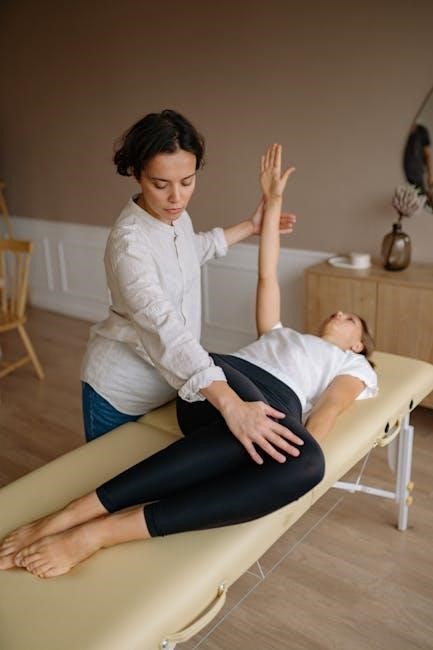Exercises for rotator cuff tendinitis are available in a downloadable pdf document with instructions and illustrations to help strengthen and stretch muscles, using
tags
for easy navigation and reading online now.
Understanding the Condition
Rotator cuff tendinitis is a common condition that occurs in patients between the ages of 40-70, and it is essential to understand the cause and symptoms to develop an effective treatment plan. The rotator cuff muscles act to stabilize the head of the humerus, and injury can occur due to a traumatic event or chronic overuse. According to online resources, symptoms of rotator cuff tendinitis include pain or weakness with arm movements or overhead activities. A doctor or physical therapist can help diagnose the condition and create a personalized exercise program. The program typically includes a series of rotator cuff tendinitis exercises, such as isometric shoulder external rotation and stretching exercises, which can be found in a downloadable pdf document with instructions and illustrations. By understanding the condition and its symptoms, individuals can take the first step towards recovery and developing a safe and effective exercise program. This understanding is crucial for creating a treatment plan that addresses the specific needs of the individual.
Symptoms of Rotator Cuff Tendinitis
Symptoms of rotator cuff tendinitis typically include pain or weakness with arm movements or overhead activities, and can range from mild to severe. The pain may be felt in the shoulder, arm, or shoulder blade, and can worsen with activity or at night. According to online resources, other common symptoms include limited mobility or stiffness in the shoulder, and a clicking or snapping sound when moving the shoulder. A doctor or physical therapist can help diagnose the condition and determine the best course of treatment. The symptoms of rotator cuff tendinitis can impact daily activities, making it essential to address the condition promptly. By recognizing the symptoms, individuals can seek medical attention and begin a treatment plan, which may include exercises and physical therapy. The goal of treatment is to alleviate symptoms and improve range of motion, allowing individuals to return to their normal activities. A downloadable pdf document can provide more information on symptoms and treatment options.

Types of Rotator Cuff Exercises
Exercises include isometric and stretching to strengthen muscles using
- ordered lists
for easy reference online now always.
Isometric Shoulder External Rotation
Isometric shoulder external rotation is an exercise that can help strengthen the muscles of the rotator cuff, and it is often included in a downloadable pdf document with instructions and illustrations. This exercise can be done by standing in a doorway with the elbow bent at a 90-degree angle and the back of the wrist pressing against the door frame. The individual should then try to press their hand outward into the door frame, holding for 5 seconds and doing 3 sets of 10. This exercise can help improve the strength and stability of the shoulder joint, and it can be modified to suit different levels of ability. Using online resources and
- ordered lists
can provide more information on how to perform this exercise correctly and safely. Additionally, consulting with a doctor or physical therapist can help determine the best exercises for a specific condition, and provide guidance on how to progress with the exercises over time to achieve the best results.
Stretching Exercises
Stretching exercises are an essential part of any rotator cuff tendinitis exercise program, and can be found in a downloadable pdf document with instructions and illustrations. These exercises can help improve flexibility and reduce stiffness in the shoulder joint, making it easier to perform daily activities. Using
- unordered lists
and
- ordered lists
can provide a clear outline of the different stretching exercises that can be done, such as shoulder rolls and arm circles. It is also important to use online resources to learn how to perform these exercises correctly and safely. Stretching exercises should be done gently and within a comfortable range of motion, and should not cause any pain or discomfort. By incorporating stretching exercises into a regular exercise routine, individuals can help improve their overall shoulder health and reduce the risk of further injury. Regular stretching can also help improve posture and reduce muscle tension, leading to a more comfortable and active lifestyle.

Importance of Supervision
Exercises require medical supervision to ensure safety and effectiveness using
paragraphs
for clear guidance always.
Doctor or Physical Therapist Supervision

Having a doctor or physical therapist supervise exercises is crucial for individuals with rotator cuff tendinitis, as they can provide personalized guidance and feedback to ensure proper technique and progress.
Using online resources and
instructional videos
can also be helpful in understanding the exercises, but supervision from a medical professional is essential to prevent further injury and promote healing.
They can help individuals modify exercises to suit their specific needs and abilities, and also provide encouragement and support throughout the rehabilitation process.
Additionally, a doctor or physical therapist can monitor progress and adjust the exercise program as needed to ensure optimal results.
By working with a medical professional, individuals with rotator cuff tendinitis can ensure a safe and effective recovery, and return to their normal activities with confidence and strength, using
- ordered lists
to track progress and stay motivated.
This supervision is a critical component of a comprehensive rehabilitation program, and can make a significant difference in the outcome of treatment, with
- unordered lists
of benefits including improved range of motion and reduced pain.
Return to Daily Activities
Returning to daily activities after experiencing rotator cuff tendinitis requires a gradual and careful approach, using exercise programs and
rehabilitation strategies
to ensure a safe and successful recovery.
Individuals can start by incorporating gentle exercises into their daily routine, such as
- ordered lists
of stretches and strengthening exercises, to improve flexibility and strength.
As they progress, they can gradually increase the intensity and duration of their activities, using
- unordered lists
to track their progress and stay motivated.
It is essential to listen to their body and avoid activities that exacerbate the condition, using
headers
to organize and prioritize their rehabilitation plan.
By following a well-structured rehabilitation program and being mindful of their limitations, individuals can return to their daily activities with confidence and strength, and reduce the risk of further injury or complications, using
to monitor their progress and adjust their program as needed.
This approach enables individuals to regain their independence and resume their normal activities, while also promoting long-term health and wellness.

Access to Exercise Instructions
Exercises are available through a download link and online
menus for easy access now.
